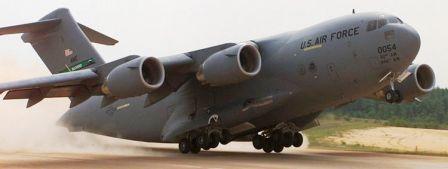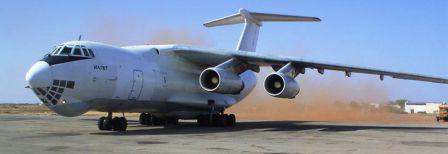Boeing C-17 and Ilyushin Il-76 Jet Aircraft
Keeping in mind that bush planes come in all sizes and shapes and, that by definition bush planes are operated in remote locations out of small strips, the Boeing C-17 and Ilyushin Il-76 are the largest bush planes in the world. Admittedly, they are a far stretch from what most people would consider bush planes, but these aircraft jet have both seen their fair share of rugged and remote areas. Bottom line, if a person (or more likely, organization) needs to haul a ton of cargo or passengers to an incredibly remote location, the C-17 and Il-76 are the only practical airplanes available. Other, even larger planes arguably fit this category (such as the Lockheed C-5 Galaxy and Antonov An-225 Myria), but neither plane has operated in as rugged and remote locations as the Boeing and Ilyushin jet aircraft.

These are both very large aircraft jets (and neither are offered in kit form!). The first Boeing C-17 was the T1. The US Air Force awarded the contract to Boeing for the T1 in 1981. It was manufactured in Long Beach, California and took off in 1991. The latest version of the C-17 is the Globemaster III which will cease production in September, 2014 after Boeing delivers its 223rd C-17 to the US Air Force and produces 17 more planes to fill foreign orders. Boeing announced the closure of it's Long Beach production plant was due to market trends and timing of expected orders.
The Ilyusion dates from the late 60s and is still in production in Uzbekistan.

These jet aircraft are literally capable of hauling battle tanks and are included in this website only for general interest. The organizations operating these jet aircraft are well-aware of their need for such an aircraft and even though bush-planes.com is a world-renowned and mighty website, it is doubtful anyone will decide they need a C-17 or Il-76 because they looked like the right plane for their job based on this website.
The Ilyushin Il-76 (NATO reporting name: Candid) is a multi-purpose 4-engined strategic airlifter designed by the Soviet Ilyushin bureau. It was first planned as a commercial freighter in 1967. Intended as a replacement for the An-12, the Il-76 was designed for delivering heavy machinery to remote, poorly-serviced areas of the USSR. Military versions of the Il-76 have seen widespread use in Europe, Asia and Africa, including use as an airborne refueling tanker or as a command center.
Watch this cockpit view of an IL-76 take-off.
The Il-76 has seen extensive service as a commercial freighter for ramp-delivered cargo, especially for outsized or heavy items unable to be otherwise carried. It has been used as emergency response transport for civilian evacuations and to deliver humanitarian/disaster relief aid around the world, especially to undeveloped areas due to its ability to operate from unpaved runways. A water-carrying version of the plane has been effective in fire-fighting. There is also a model used for zero-G training.
Watch this US Air Force C-17 perform a combat airlift from a remote Afghani airfield. After takeoff the C-17 stays low to build speed and then pulls up into an incredible rapid climb.
The Boeing C-17 performs outside the combat zone just as well. Watch this short field landing at the Wings over Houston airshow in Texas, USA.
Watch the IL-76 Silk Way take-off.
An Il-76 on a fire fighting mission in California.
Here is a QATAR Air Force Boeing C-17 Globemaster landing at Maastricht.
This next video features a IL-76 landing in Khartoum, Sudan in Africa.
Watch this IL-76 on a low pass in Antarctica.
This is a rare video clip about a day in the life of a soviet bomber crew flying the massive Tupolev 95. The "Bear" is the world's fastest propeller driven aircraft powered by four 14,795 shp engines driving counterrotating propellers. Other aircraft in this clip are a Il-76 Midas tanker and a couple Norwegian F-16's. Watch this IL-76 refuel the TU-95 Bear.
Watch the latest videos on YouTube.com
Jeremy Morris, an Air Force maintenance officer and 16 year aircraft mechanic wrote in to let us know he prefers the C-5 over the C-17. Here is what he had to say, "For the record, C-5s have the capability to land anywhere a C-17 can land (assuming it physically fits on the runway) because C-5s originally incorporated a central tire deflation/inflation system for landing on unimproved runways, with 24 breaks and 4 TRs pushing out 28K LBS of REV thrust each. I have been deep into the Iraq boonies, Djibouti Africa, if you do some searching on it C-5s have even served in Antarctica, it doesn't get more remote than that. Additionally the C-5 Super Galaxy actually out performs the C-17 with twice the cargo and even more fuel efficiency!"
Thanks for your input, Jeremy. This is good information.